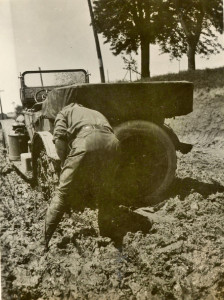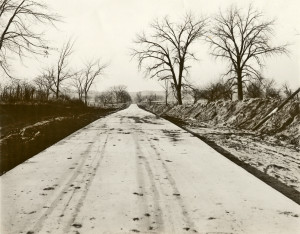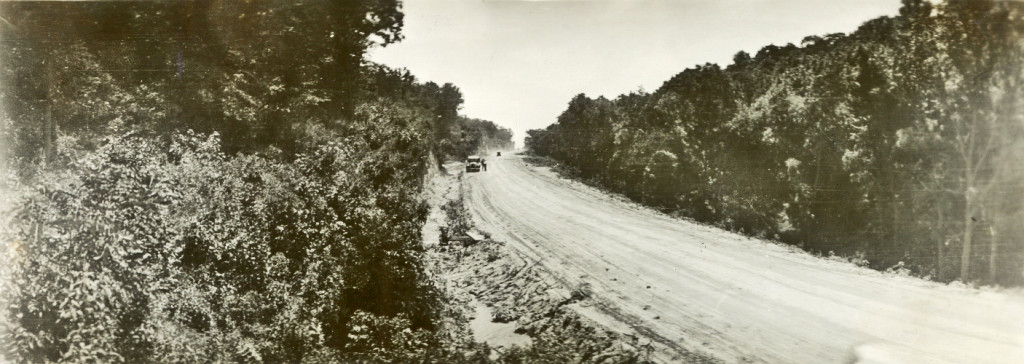Lincoln Highway History
Brief History of the Lincoln Highway
In the years before highways, railroads were the primary method of interstate travel. Whereas roadways were more used more locally.

Digging a car out of mud near Tama by AF Bement and H Joy 1915 © Lincoln Highway Association Archive Transportation History Collection Special Collections Library University of Michigan
Carl G. Fisher was an early automobile industry entrepreneur, he was one of the principal investors who built the Indianapolis Motor Speedway and was also a manufacturer of early gas headlights used in early automobiles. He had a dream of a transcontinental highway, and in 1912 he began to promote that dream. He believed the popularity of automobiles was dependent on the quality of roads, so if there was a nice road to drive on there would be more cars. He hatched the idea of a cross-country highway that would enable automobile travelers to get in their cars, get on the road, and enjoy traveling. Within months of pitching the idea, he had gathered $1 million in funds. Major contributors included Teddy Roosevelt, Thomas Edison (both friends of Fisher), and then President, Woodrow Wilson.
Before development of the highway could begin, the idea needed to generate proper momentum so that it could be built. Thus, the Lincoln Highway Association was created on July 1, 1913 to “to procure the establishment of a continuous improved highway from the Atlantic to the Pacific, open to lawful traffic of all description without toll charges.” Their job was to get the highway built, and promote it.
In July 1913 the LHA sent out a group of people called the “Trail-blazers” to scout the western route of the highway. They set it up as a tour that started in Indianapolis and ended in San Francisco. The “Trail-Blazer” tour spent 34 days touring through several states across America exploring possible routes for the Lincoln. However, when the official highway route was announced it didn’t necessarily follow the route the “Trail-blazers” took because the LHA President Henry Joy wanted as straight a route across the country as possible. The LHA officially dedicated the route on October 31, 1913. The dedication was celebrated all across the proposed route with parades, fireworks, bonfires, dances, and concerts.
Later that same year, the Essex and Hudson Lincoln Way in New Jersey became the first section of the Lincoln to be completed. It was dedicated on December 13, 1913. With the dedication of this section, the first automobile road across America was born. Upon the Lincoln Highway’s official dedication, it also became the first official memorial to Abraham Lincoln.
Early travel on the Lincoln was about what you would expect in that time period. The Association determined that it would take a traveler 20-30 days to drive from the East coast to the West coast. The motorist would need to average about 6 hours of travel a day at 18 miles per hour. The Association thought that it should cost no more than $5 a day per person, with the exception of car repairs. Keep in mind that traveling was only done during the light of day.
In 1914, the Lincoln Highway Association didn’t have sufficient funds to sponsor large sections of the road so they started the “Seedling Miles” project. The Seedling Miles project (Iowa’s is located outside Cedar Rapids) was intended to “demonstrate the desirability of this permanent type of road construction” to rally public support for government-backed construction. The first Seedling Mile was built in Malta, Illinois.

Seedling Mile in Linn County 6 miles east of Cedar Rapids 1915 © Lincoln Highway Association Archive Transportation History Collection Special Collections Library University of Michigan
After years of experience with constructing roads the LHA began to design a section of road that could handle traffic for 20 years. Several highway experts convened between December 1920 and February 1921 and were able to come up special set of highway guidelines that should be followed. The most famous Seedling Mile that was built to these specifications is a 1.3-mile section that resides in Lake County, Indiana. It is named the “Ideal Section “ and was constructed during 1922 and 1923. It was praised for its functionality and was visited and written about in technical papers across the United States and overseas. To this day, the Ideal Section is still in use and has aged so well that a driver wouldn’t notice how old it was without the special marker bringing attention to it.
In 1926 a new highway numbering was adopted and states began putting up new signs to mark the highways. The Lincoln Highway was split into multiple numbered sections, but the entire route between Philadelphia and Granger, Wyoming was assigned “U.S 30.”
After 1926, LHA donations diminished, and meeting attendance dropped. The Lincoln Highway dream had been made a reality and was actively being built -and even rebuilt- with a secure source of public funds as part of a national grid of interstate highways. Its goals fulfilled, the LHA disbanded on December 31, 1927 after having made a resolution to mark the route one final time. Even with the re-routings and the new federal highway numbers, the identity of the Lincoln Highway did not die with the LHA. The image made for the highway was by then too deeply seated. Throughout the 1930s and 1940s, many piecemeal road relocations were considered as improvements to the Lincoln Highway, and not as hindrances of the Lincoln Highway.
The Lincoln Highway Association was reformed in 1992. Its mission was “…to identify, preserve, and improve access to the remaining portions of the Lincoln Highway and its associated historic sites.” Since then the LHA, and its state chapters, have been working to fulfill that mission to the best of their ability.
Explore author Brian Butko’s websites for more expert information about the Lincoln Highway.
https://brianbutko.wordpress.com/ or https://lincolnhighwaynews.wordpress.com/

Grade on Honey Creek Hill, Pottawattamie County 1921 © Lincoln Highway Association Archive Transportation History Collection Special Collections Library University of Michigan
